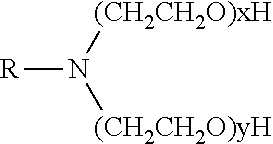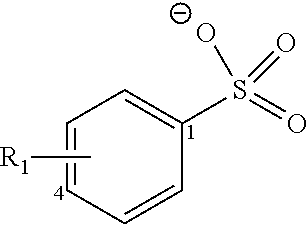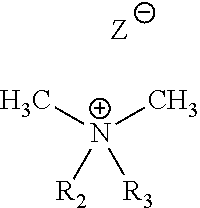Composition and Method for Treating Wood
a technology for treating wood and wood chips, applied in the field of composition for treating wood, can solve the problems of increasing the water content of wood, shrinking of wood, and the appearance of wood, and achieve the effect of reducing the us
- Summary
- Abstract
- Description
- Claims
- Application Information
AI Technical Summary
Benefits of technology
Problems solved by technology
Method used
Image
Examples
example 1
Emulsion Stability
[0112]Emulsions were prepared with varying ratios of non-polar white spirits and polar water phases.
[0113]A surfactant system comprising two surfactants, non-ionic polyethoxylated oleylamine (Huntsman Teric 16M2) and anionic 57% linear dodecyl benzene sulfonate in 2-ethylhexanol (Nansa EVM 70 / 2E) was prepared by mixing the non-ionic surfactant and anionic surfactant in a ratio of 4:1.
[0114]The surfactant system was added to the white spirits in an amount that provides varying concentrations, 0.1, 0.3, 0.45 and 1.0 v / v of the total emulsion composition. The required volume of water was added to provide the required ratio of white spirit to water, 20:80, 40:60, 50:50, 60:40, 70:30 and 80:20. The composition was mixed by high shear mixing for 15 seconds.
[0115]The emulsion stability was assessed by monitoring the time taken for the two phases to separate. The emulsion was considered stable if there was no separation in 2 hours. If separation of the phases occurs within...
example 2
Emulsion Stability
[0118]The method of Example 1 was repeated with the non-ionic and anionic surfactant system at concentrations of 0.1, 0.2, 0.35 and 0.45% v / v. After preparation of the emulsion, benzylalkonium chloride (BAC) was added at a concentration of 1% v / v (1.5 g / L of 150 g / L solution) and the composition was subject to about 1 minute further high shear mixing.
[0119]The stability of the emulsions was assessed as for Example 1. The results are shown in Table 2:
TABLE 2Carrier% White% surfactant system + 1% v / v BACSpirits% Water0.100.20.350.452080StableStableStableStable4060StableStableStableStable5050StableStableStableStable6040UnstableStableStableStable7030UnstableStableStableStable8020UnstableUnstableUnstableStable
[0120]The inclusion of BAC improved the stability of the emulsions.
example 3
Emulsion Stability
[0121]The method of Example 1 was repeated using High Flash kerosene as the non-polar phase. The stability of the emulsions was assessed and the results are shown in Table 3:
TABLE 3Carrier% High Flash% v / v mixed SurfactantsKerosene% Water0.100.30.451.02080StableStableStableStable4060StableStableStableStable5050StableStableStableStable6040UnstableStableStableStable7030UnstableUnstableStableStable8020UnstableUnstableUnstableStable
PUM
 Login to View More
Login to View More Abstract
Description
Claims
Application Information
 Login to View More
Login to View More - R&D
- Intellectual Property
- Life Sciences
- Materials
- Tech Scout
- Unparalleled Data Quality
- Higher Quality Content
- 60% Fewer Hallucinations
Browse by: Latest US Patents, China's latest patents, Technical Efficacy Thesaurus, Application Domain, Technology Topic, Popular Technical Reports.
© 2025 PatSnap. All rights reserved.Legal|Privacy policy|Modern Slavery Act Transparency Statement|Sitemap|About US| Contact US: help@patsnap.com



